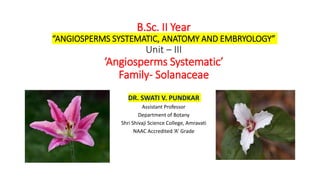
Solanaceae
- 1. B.Sc. II Year “ANGIOSPERMS SYSTEMATIC, ANATOMY AND EMBRYOLOGY” Unit – III ‘Angiosperms Systematic’ Family- Solanaceae DR. SWATI V. PUNDKAR Assistant Professor Department of Botany Shri Shivaji Science College, Amravati NAAC Accredited ‘A’ Grade
- 4. Solanaceae, the nightshade, or potato, family of flowering plants (order Solanales), with 102 genera and nearly 2,500 species, many of considerable economic importance as food and drug plants. Among the most important of those are potato (Solanum tuberosum); eggplant (S. melongena); tomato (S. lycopersicum); peppers (various Capsicum species); tobacco (Ni cotiana tabacum and N. rustica); belladonna (Atropa belladonna); the poisonous jimsonweed (Datura stramonium) and nightshades (S. nigrum, S. dulcamara, and others); and many garden ornamentals, such as the genera Browallia, Brugmansia, Brunfelsia, Cestrum, Datura, L ycium, Nicotiana, Nierembergia, Petunia, Salpiglossis, Schizan thus, Solandra, Solanum, and Streptosolen.
- 5. Members of the Solanaceae family are found throughout the world but are most abundant and widely distributed in the tropical regions of Latin America, where about 40 genera are endemic. Very few members are found in temperate regions, and only about 50 species are found in the United States and Canada combined. The genus Solanum contains almost half of all the species in the family, including all the species of wild potatoes found in the Western Hemisphere. The poisonous alkaloids present in some species of the family have given the latter its sombre vernacular name of “nightshade.”
- 6. •angel’s trumpet (Brugmansia genus) •belladonna (Atropa belladonna) •datura (genus Datura)jimsonweed (Datura stramonium) •ground cherry (genus Physalis) •henbane (Hyoscyamus niger) •mandrake (genus Mandragora) •nightshade (genus Solanum)buffalo bur (Solanum rostratum) •eggplant (Solanum melongena) •potato (Solanum tuberosum) •tomato (Solanum lycopersicum) •woody nightshade (Solanum dulcamara) •pepper (genus Capsicum)bell pepper (Capsicum annuum) •cayenne pepper (Capsicum annuum) •chili pepper (Capsicum species) •pimiento (Capsicum annuum) •tabasco pepper (Capsicum frutescens) •petunia (genus Petunia) •tobacco (Nicotiana tabacum and N. rustica)
- 8. Primitive characters: 1. Shrubs, trees and perennial climbers. 2. Leaves simple and alternate. 3. Inflorescence solitary axillary or terminal. 4. Flowers actinomorphic, hermaphrodite and hypogynous. 5. Pollination by insects. 6. Ovules numerous in each loculus. 7. Stamens dithecous. 8. Seeds endospermic. Advanced characters: 1. Most of the plants are herbaceous and many are annuals. 2. Leaves exstipulate, in some finely divided. 3. Calyx and corolla are gamosepalous and gamopetalous. 4. Stamens epipetalous. 5. Reduction in the number of carpels to two. 6. Gynoecium is syncarpous. 7. Fruit is simple.
- 9. Habit: The species belonging to this family are either erect or climbing herbs, shrubs or small trees. Solanum nigrum is a small annual herb; species of Datura are large annual herbs. Cestrum nocturnum is a shrub. Root: Tap or adventitious. Stem: Herbaceous or woody, erect or twining or creeping; sometimes modified into tubers (Potato).
- 10. Leaves: Alternate or becoming opposite at or near the inflorescences, rarely whorled, exstipulate, entire, simple, rarely dissected or pinnate.
- 11. Inflorescence: Cymose usually a typical axillary cyme or combination of cymes, rarely helicoid.
- 12. Flowers: Usually pedicellate, hermaphrodite, actinomorphic, regular (sometimes slightly zygomorphic), hypogynous complete, bracts and bracteoles absent.
- 13. Calyx: 5 sepals, gamosepalous (limb usually 5-lobed or-toothed), persistent and often much enlarged in fruit. Corolla: 5 petals, gamopetalous, funnel shaped, rotate to tubular, corolla of various shapes but rarely 2-lipped, usually plicate or convolute (rarely valvate).
- 14. Androecium: 5 stamens, sometimes 4 and didynamous or not so, or only 2, e.g., Schizanthus; when the stamens are less than five the lost stamen is usually represented by a reduced (staminode). Stamens epipetalous and alternate, the petals, usually not equal in size. Anthers are 2-celled (dithecous), introrse, dehiscence by longitudinal slit or by apical pore, e.g., in Solarium, the connective sometimes enlarged, usually hypogynous disc present which is quite apparent.
- 15. Gynoecium: 2 carpels (bicarpellary), syncarpous, ovary superior, bilocular (sometimes becomes tetralocular due to false septation), rarely 3-5 celled ovary, placentation axile, ovules usually many on prominently peltate placentas, anatropous or somewhat amphitropous. The carpels placed obliquely in the flowers. Single style, stigma bi-lobed and capitate.
- 16. Fruit: A berry or septicidal capsule. Seed: Albuminous (endospermic) smooth or pitted, curved embryo embedded in the endosperm.
- 19. Economic Uses: - 1.Food-This family contains many species of great economic importance. These include potato (Solanum tuberosum), tomato (Lycopersicon esculentum), and the peppers (various Capsicum spp.). - Many members are also cultivated for their alkaloid content. The most important example is tobacco (Nicotiana tabacum). - Various members of this family are also grown as ornamentals. 2. Medicinal: Atropa belladona contains alkaloid Atropine; this is used in Belladona plaster. Atropine is used in eye testing. Nicotiana tabacum (tobacco) yields Nicotine. Hyoscyamus niger, Solanum nigrum, Datura (H. Dhatura), Withania somnifera (Ashwagandha) are used medicinally.
- 20. 3. Narcotics: Tobacco is obtained from leaves of Nicotiana tabacum and variously used in cigars, bidi, chewing, jarda etc. 4. Ornamentals: Petunia, Cestrum, Lycium, Salpiglossis, Schizanthus are cultivated in gardens for ornamentals.